Chloroprene rubber offers superior weather resistance, chemical stability, and adhesion to diverse surfaces compared to natural rubber, making it ideal for high-performance adhesives. Natural rubber provides excellent initial tack and flexibility but lacks durability in harsh environments.
Table of Comparison
| Property | Chloroprene Rubber (CR) | Natural Rubber (NR) |
|---|---|---|
| Adhesion Strength | High, excellent bonding to metal and textiles | Moderate, good adhesion but less chemical resistance |
| Chemical Resistance | Good resistance to oils, solvents, and weathering | Poor resistance, susceptible to oils and solvents |
| Temperature Range | -40degC to 120degC | -50degC to 70degC |
| Elasticity | Good elasticity and compression set resistance | Excellent elasticity but poor compression set |
| Durability | High durability with UV and ozone resistance | Lower durability, prone to aging and oxidation |
| Application Suitability | Ideal for outdoor and industrial adhesive applications | Better suited for indoor, low-exposure adhesive uses |
Introduction to Chloroprene Rubber and Natural Rubber
Chloroprene rubber, also known as polychloroprene, is a synthetic elastomer renowned for its excellent chemical stability, weather resistance, and strong adhesive properties, making it ideal for industrial adhesive applications. Natural rubber, derived from latex sap of the Hevea brasiliensis tree, offers superior elasticity and tensile strength but is more susceptible to environmental degradation such as oxidation and ozone exposure. The distinct molecular structure of chloroprene rubber provides enhanced durability and resistance in adhesives, whereas natural rubber excels where flexibility and tackiness are prioritized.
Chemical Structure and Composition Differences
Chloroprene rubber (CR) features a polychloroprene polymer structure with chlorine atoms replacing some hydrogen atoms, providing enhanced chemical resistance and weatherability compared to natural rubber (NR), which primarily consists of cis-1,4-polyisoprene. The presence of chlorine in chloroprene rubber contributes to its superior adhesion properties, especially in bonding to metals and various substrates under harsh environmental conditions. Natural rubber's unsaturated hydrocarbon backbone offers excellent tack and flexibility but is more vulnerable to oxidation, ozone, and chemical degradation, impacting its adhesive durability.
Key Physical Properties Comparison
Chloroprene rubber (CR) exhibits superior chemical resistance and enhanced weathering performance compared to natural rubber (NR), making it ideal for adhesive applications exposed to harsh environments. CR offers higher tensile strength and improved abrasion resistance, while NR provides excellent elasticity and tackiness for bonding flexibility. The thermal stability of chloroprene rubber also surpasses that of natural rubber, ensuring longer durability and consistent adhesive performance under varying temperatures.
Adhesion Performance in Various Applications
Chloroprene rubber exhibits superior adhesion performance compared to natural rubber across a wide range of applications, including automotive, construction, and industrial uses, due to its excellent resistance to oils, chemicals, and weathering. Its unique molecular structure enhances bonding strength on diverse substrates such as metals, plastics, and fabrics, making it ideal for demanding environments. Natural rubber, while offering good initial tack and flexibility, tends to exhibit lower chemical resistance and weaker long-term adhesion in harsh conditions, limiting its use in specialized adhesive applications.
Resistance to Environmental Factors
Chloroprene rubber exhibits superior resistance to ozone, UV radiation, and weathering compared to natural rubber, making it ideal for outdoor adhesive applications. Its chemical stability enables it to maintain flexibility and adhesion strength under harsh environmental conditions such as exposure to oils, solvents, and temperature fluctuations. Natural rubber, while offering excellent elasticity and tensile strength, tends to degrade faster when exposed to ozone and UV light, reducing its effectiveness as a durable adhesive in demanding environments.
Processing and Application Techniques
Chloroprene rubber offers superior chemical resistance and weather durability compared to natural rubber, making it ideal for adhesive formulations exposed to harsh environments. Processing chloroprene involves solvent-based systems and requires careful control of curing agents to achieve optimal flexibility and adhesion properties. Natural rubber adhesives, favored for their exceptional tack and elasticity, are typically processed using latex-based techniques suitable for pressure-sensitive applications like tapes and labels.
Cost and Availability Considerations
Chloroprene rubber offers moderate cost advantages and consistent availability due to synthetic production, making it a reliable choice for adhesive manufacturers managing supply chain stability. Natural rubber, derived from natural latex, often incurs variable pricing influenced by agricultural conditions and geopolitical factors, potentially leading to higher overall costs. Availability of chloroprene rubber remains more predictable in large-scale industrial applications, while natural rubber supply can fluctuate seasonally and regionally, impacting adhesive formulation strategies.
Durability and Longevity in Adhesive Use
Chloroprene rubber exhibits superior durability compared to natural rubber due to its excellent resistance to weathering, ozone, and chemical exposure, making it ideal for adhesive applications exposed to harsh environments. The enhanced oxidation resistance of chloroprene ensures longer service life and consistent bonding strength over time, whereas natural rubber tends to degrade faster under similar stress conditions. Consequently, adhesives formulated with chloroprene rubber demonstrate improved longevity and reliability in demanding industrial and outdoor applications.
Suitability for Industrial vs. Consumer Adhesives
Chloroprene rubber offers superior chemical resistance, weatherability, and aging stability, making it highly suitable for industrial adhesives used in automotive, construction, and heavy-duty applications. Natural rubber provides excellent initial tack and flexibility, which is ideal for consumer adhesive products like tapes and glues for everyday use but lacks long-term durability under harsh conditions. The choice between chloroprene and natural rubber depends on performance requirements, with chloroprene preferred for demanding industrial environments and natural rubber favored for general-purpose consumer adhesives.
Sustainability and Environmental Impact
Chloroprene rubber demonstrates strong resistance and durability in adhesive applications but is derived from petrochemical sources, contributing to higher environmental footprints compared to Natural rubber, which is renewable and biodegradable. Natural rubber adhesives offer enhanced sustainability through carbon sequestration in rubber plantations and lower lifecycle emissions, making them preferable for eco-friendly products. However, performance limitations and allergenic concerns in Natural rubber adhesives necessitate careful material selection based on application requirements.

Infographic: Chloroprene rubber vs Natural rubber for Adhesive
 azmater.com
azmater.com